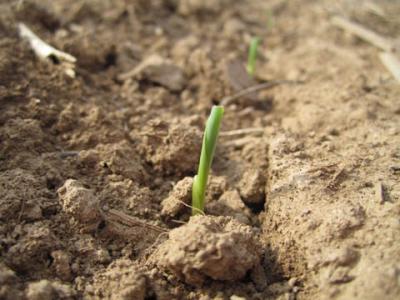Dry weather causing some early season concerns
Dry weather causing some early season concerns

Dry weather this spring has some producers worrying about young crops already in the ground or those soon to be.
While the entire state received some much needed rain in the past few days, additional rainfall is needed to help the ground recover from one of the driest Aprils on record. In April, state rainfall totals averaged a little more than 2 inches of rain, which is slightly lower than half of the normal rainfall amount for the month. Western Kentucky was the driest area, only receiving slightly more than 1 inch of rain in April. Half of the state is considered abnormally dry or in moderate drought, said Tom Priddy, meteorologist in the University of Kentucky College of Agriculture.
The lack of rain has sped up row crop planting. As of May 7, Kentucky corn growers had planted 92 percent of this year’s crop and 76 percent had emerged, according to the National Agricultural Statistics Service Weekly Crop and Weather Report. This is well ahead of the five-year average planting rate of 56 percent and five-year average emergence rate of 35 percent.
Fortunately, young corn seedlings do not require a lot of water and even small rains will help the crop, said Chad Lee, UK grain crops specialist. While the topsoil may be dry, the young plants’ root systems may be able to reach water that’s available deeper in the soil. If they can’t, the plants will begin to show drought symptoms. Lee said producers should scout their fields for plants showing signs of drought stress. If drought symptoms are found, producers should dig around plants that are showing these symptoms as well as those that aren’t to see the root system and determine whether soil compaction is playing a role in keeping the plants from water.
Drought stress early in plant development (until growth stage V4 or V5) should result in minimal yield loss. Yield losses become more significant if drought conditions persist as plants reach the tasseling and ear development (V6) growth stage, Lee said.
As of May 7, producers had also planted 33 percent of their soybean crops according to the Weekly Crop and Weather Report. This is also ahead of the five-year average planting rate of 4 percent.
When planting soybeans into dry ground, producers should not plant the seedlings deeper into the soil to help them reach available moisture. UK specialists recommend soybean planting depths of 1 to 1.5 inches for maximum germination and no deeper than 2 inches in dry ground. Planting soybeans at depths greater than 2 inches can cause delayed emergence and increases the risk that the seedling will not reach the soil surface, Lee said. For those who haven’t planted yet, it would be ideal to plant the seedlings at recommended depths after a rain.
For more information on soybean planting, view UK extension publication AGR 130: Soybean Planting in Kentucky.
Extension Weather

